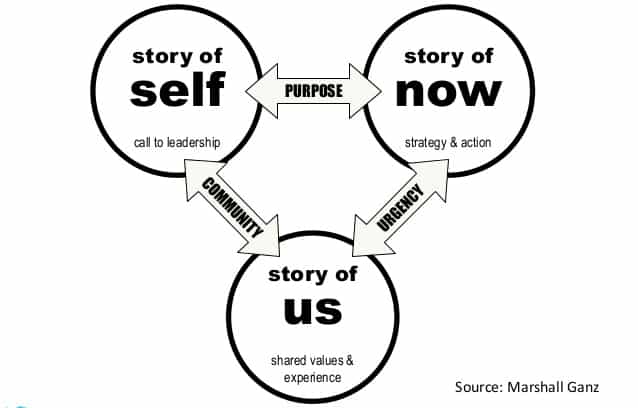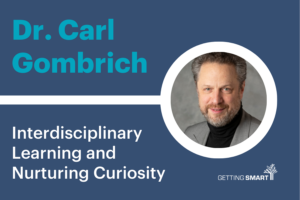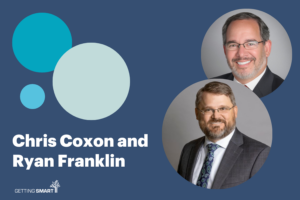Why Should We Teach Storytelling? 5 Reasons to Start Today

As part of the Opportunity Youth movement to support out-of-work and out-of-school youth, I traveled with low-income young people from across the US to Capitol Hill. We met with elected officials and staffers to advocate for organizations that are moving the needle in creating education and work opportunities like Year Up and YouthBuild.
So how were unemployed “dropouts” able to connect with policymakers on education? Solid data, and storytelling. This experience sparked new thinking for me that storytelling in classrooms should go beyond demonstrating content knowledge. Here are five reasons why we should be creating storytelling opportunities for students today.
1. Stories communicate values
At the heart of storytelling are the values we live and share. Through a story a protagonist faces a challenge, makes a choice, and that choice reflects a core belief or value.
Access to a quality education — now that’s a core belief we can all agree is important. But how do we come together and mobilize around this? Part of the answer is storytelling. When students bring policymakers, edupreneurs, education leaders, and philanthropists into the moments and emotions that reflect the importance of this core belief through storytelling, a shared experience is established between the storyteller and the listener. The listener is placed in the experience of the storyteller where empathy, understanding and consciousness are generated. These new perspectives can support in leaders stepping across the aisle, they can help investors rethink impact strategies, and they can inform education leaders when transforming systems.
2. Stories inspire action
Storytelling is the tool which inspires communities to action.
As Generation Do-It-Yourself (GenDIY) begins to address our global goals, which includes access for all to high quality education, we need leaders who can mobilize government, business, philanthropy, nonprofits and citizens. We need leaders who are willing to be bold, to collectively inspire people to act and to create cohesion across diverse groups and conflicting ideologies. Marshall Ganz, Senior Lecturer in Public Policy at Harvard describes that this mobilization will challenge the hands, the head, and the heart of leaders seeking to make a difference:
The challenge of the “hands” is one of action, of learning, of adapting, and of mastering novel skills. The challenge of the head is one of strategy, imagining how to transform one’s resources into the power needed to achieve one’s purpose. The challenge of the heart is one of motivation, of urgent need to act, and of hope for success, and the courage to risk it. This is the work of public narrative.
He goes on to describe that Public Narrative is a “leadership practice of translating values into action. It is based on the fact that values are experienced emotionally.”
Storytelling is the way we access these values. In a story, a character approaches uncertainty — a challenge — and makes a choice that communicates a value. If we wish to prepare students to mobilize and take action on our most pressing issues, we need to be training students to tell stories that speak to shared values to generate collective action.
3. Stories provide a framework for making sense of our challenges
Ganz designed the Public Narrative framework, which is one of the best scaffoldings for stories that can drive an audience to action. At its core Public Narrative is a community organizing tool. It’s comprised of three elements:
- A story of self: why you were called to what you have been called to.
- A story of us: what your constituency, community, organization has been called to its shared purposes, goals, vision.
- A story of now: the challenge this community now faces, the choices it must make, and the hope to which “we” can aspire.
4. Stories show and communicate our best selves
Students, now more so than ever, need to be generating a collection of stories that share personal bests. This information should be kept either in what Frank Bruni describes as the “student locker” or a form of digital backpack. This could be as simple as student blog, or as rich as a full portfolio of student work in what we describe in Data Backpacks: Portable Records and Learner Profiles.
5. Teaching storytelling will help students become change agents
As universities rethink their ancient admissions systems and begin to think realistically about their reviewing of student information, storytelling can be used to connect student success and passions with their calling as tool to demonstrate more authentically who they are as purpose-driven young leaders. One opportunity in this work is advocating for storytelling to be part of the Coalition for Access Affordability and Success and the XQ Super School Project.
For many students, the college admissions essay is the first time they realized the importance of telling a great story. As educators, we must train students in storytelling and public narrative (great place to start) so that the admissions essay is part of an ongoing series of stories that share a student’s bests and their unique calling. But also for when they begin to grow and develop as problem solvers who need to mobilize communities to action.
For more check out:








Scott Schimmel
I couldn't agree more, Tyler. Storytelling is powerful: the story you're currently living in, the concept of picking up the pen to write your own story, understanding the story your community is telling... Thanks for the post!
Linda Goodman
If only everyone recognized what power story has! Everyone enjoys good storytelling, and it makes learning fun. It allows us to communicate with one another on level ground.